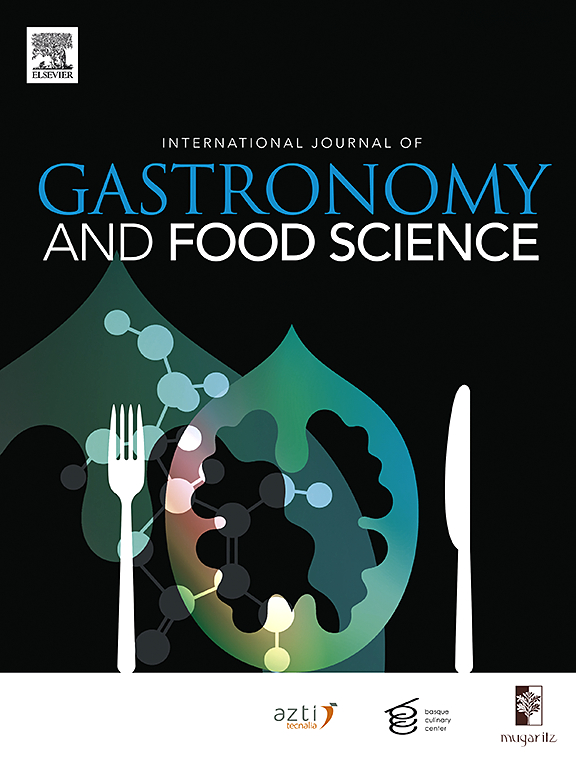Exploring the changes in flavor compounds during the storage of clear oil hot pot seasoning
IF 3.6
2区 农林科学
Q2 FOOD SCIENCE & TECHNOLOGY
International Journal of Gastronomy and Food Science
Pub Date : 2025-06-28
DOI:10.1016/j.ijgfs.2025.101234
引用次数: 0
Abstract
Clear oil hot pot seasoning (COHPS) is a traditional Chinese culinary ingredient that offers a rich and multi-layered flavor experience, making it highly popular among consumers in China. In this study, the flavor changes of COHPS during various storage periods were comprehensively analyzed using solid-phase microextraction (SPME) combined with two-dimensional gas chromatography-olfactometry-mass spectrometry (GC × GC-O-MS). A total of 91 volatiles were detected in the hotpot seasoning during the storage. The volatile compound concentrations showed an increasing and then decreasing trend, with the total volatile compound concentration reaching a maximum at 35 days. Among these, the increase in aldehydes, ketones, and esters indicates the oxidation of fats and oils, which results in undesirable flavors. A quantitative analysis of hydroxyl-α-sanshool, hydroxyl-β-sanshool, hydroxy-ε-sanshool, and capsaicin using high-performance liquid chromatography-diode array detection (HPLC-DAD) revealed that their concentrations decreased over time. The results showed that fat oxidation occurred at 7 days, and the total concentration of volatile compounds reached a maximum at 35 days, when the flavor of COHPS was most abundant, with a decrease in content starting at 42 days. At the same time, the content of sanshin and capsaicin showed a consistent decreasing trend. Therefore, we concluded that the optimal flavor storage time for COHPS was 35 days at 20 °C ± 5 °C. This study may offer new insights into the dynamic changes in the flavor of COHPS during storage.

探讨清油火锅调味料在贮存过程中风味成分的变化
清油火锅调味料(COHPS)是一种传统的中国烹饪食材,它提供了丰富和多层次的风味体验,在中国消费者中非常受欢迎。本研究采用固相微萃取(SPME)结合二维气相色谱-嗅觉-质谱(GC × GC- o- ms)技术,综合分析了COHPS在不同贮藏期的风味变化。火锅调味料在贮存过程中共检出91种挥发物。挥发性化合物浓度呈先升高后降低的趋势,总挥发性化合物浓度在35 d时达到最大值。其中,醛类、酮类和酯类的增加表明脂肪和油的氧化,从而导致不良味道。利用高效液相色谱-二极管阵列检测(HPLC-DAD)对羟基-α-三酚、羟基-β-三酚、羟基-ε-三酚和辣椒素进行定量分析,发现它们的浓度随着时间的推移而降低。结果表明,脂肪氧化发生在第7天,挥发性化合物总浓度在第35天达到最大值,此时COHPS的风味最丰富,从第42天开始含量下降。与此同时,三味素和辣椒素的含量呈一致的下降趋势。因此,在20°C±5°C条件下,COHPS的最佳风味保存时间为35 d。这一研究结果可能为研究COHPS在贮藏过程中风味的动态变化提供新的思路。
本文章由计算机程序翻译,如有差异,请以英文原文为准。
求助全文
约1分钟内获得全文
求助全文
来源期刊

International Journal of Gastronomy and Food Science
Social Sciences-Cultural Studies
CiteScore
5.30
自引率
10.50%
发文量
170
审稿时长
45 days
期刊介绍:
International Journal of Gastronomy and Food Science is a peer-reviewed journal that explicitly focuses on the interface of food science and gastronomy. Articles focusing only on food science will not be considered. This journal equally encourages both scientists and chefs to publish original scientific papers, review articles and original culinary works. We seek articles with clear evidence of this interaction. From a scientific perspective, this publication aims to become the home for research from the whole community of food science and gastronomy.
IJGFS explores all aspects related to the growing field of the interaction of gastronomy and food science, in areas such as food chemistry, food technology and culinary techniques, food microbiology, genetics, sensory science, neuroscience, psychology, culinary concepts, culinary trends, and gastronomic experience (all the elements that contribute to the appreciation and enjoyment of the meal. Also relevant is research on science-based educational programs in gastronomy, anthropology, gastronomic history and food sociology. All these areas of knowledge are crucial to gastronomy, as they contribute to a better understanding of this broad term and its practical implications for science and society.
 求助内容:
求助内容: 应助结果提醒方式:
应助结果提醒方式:


